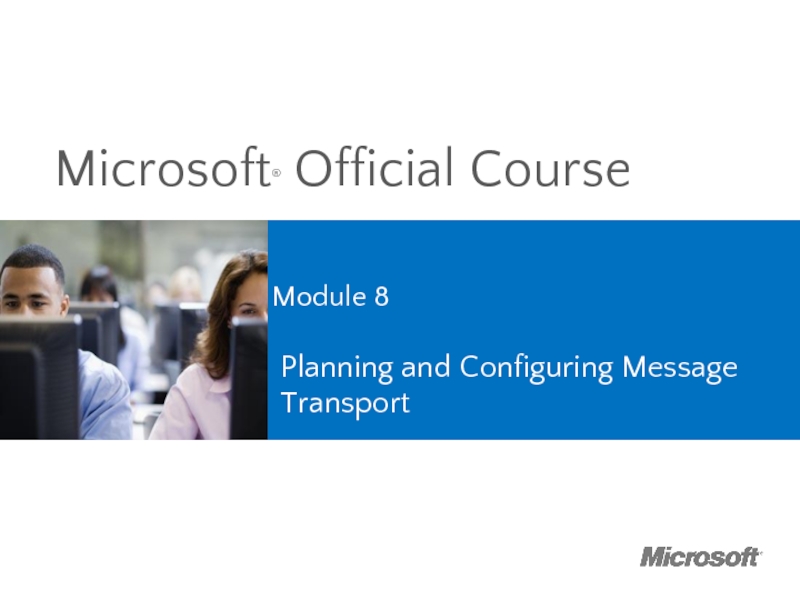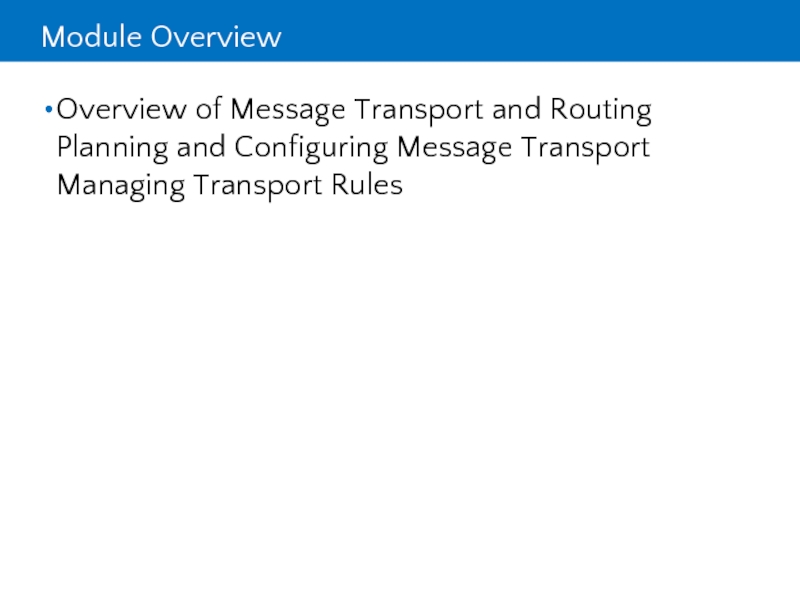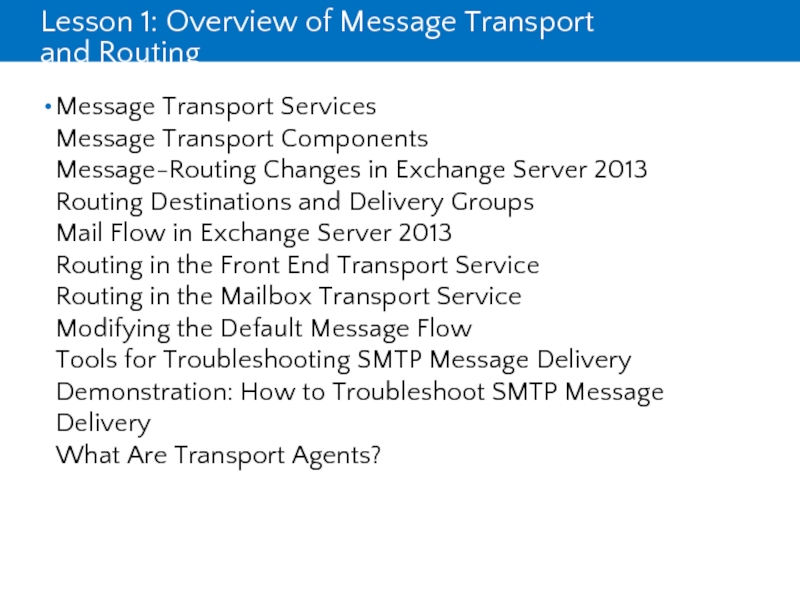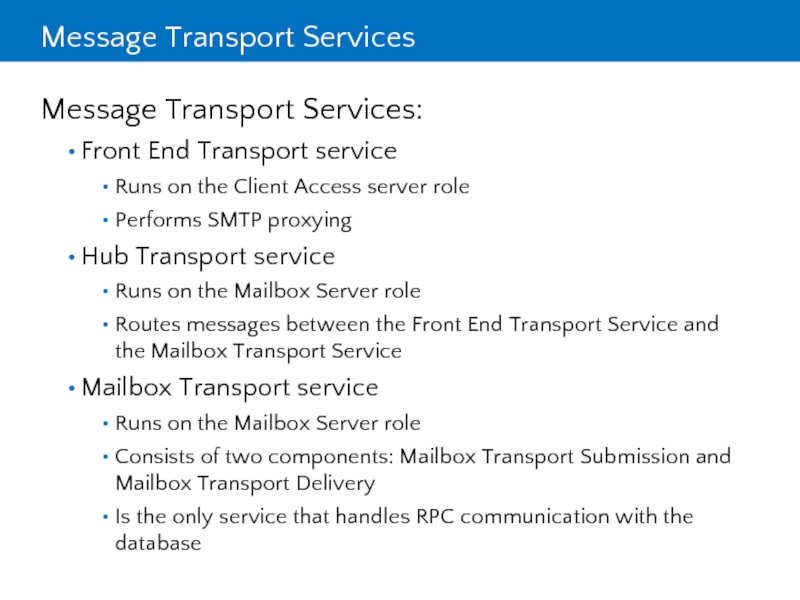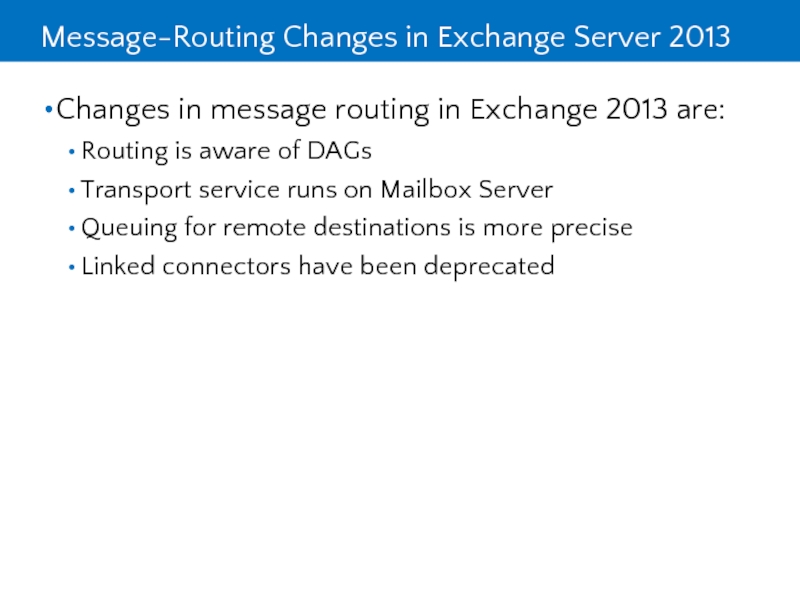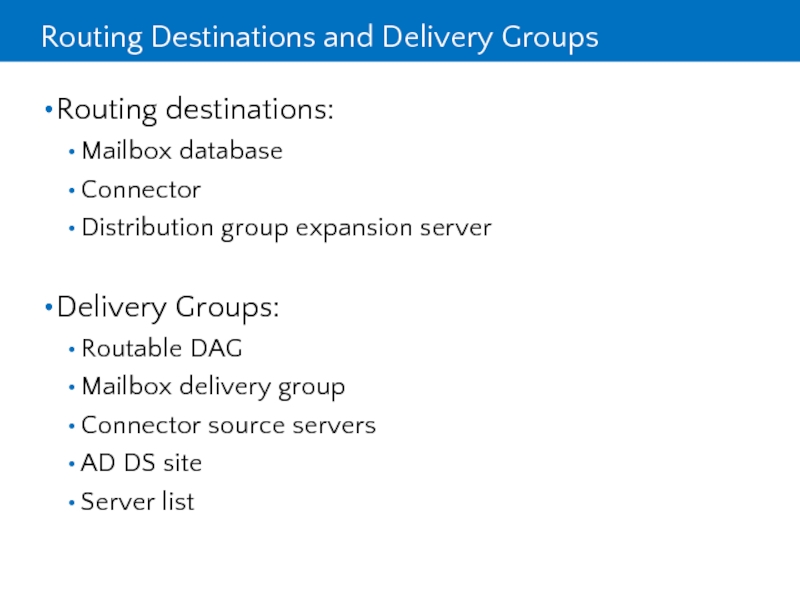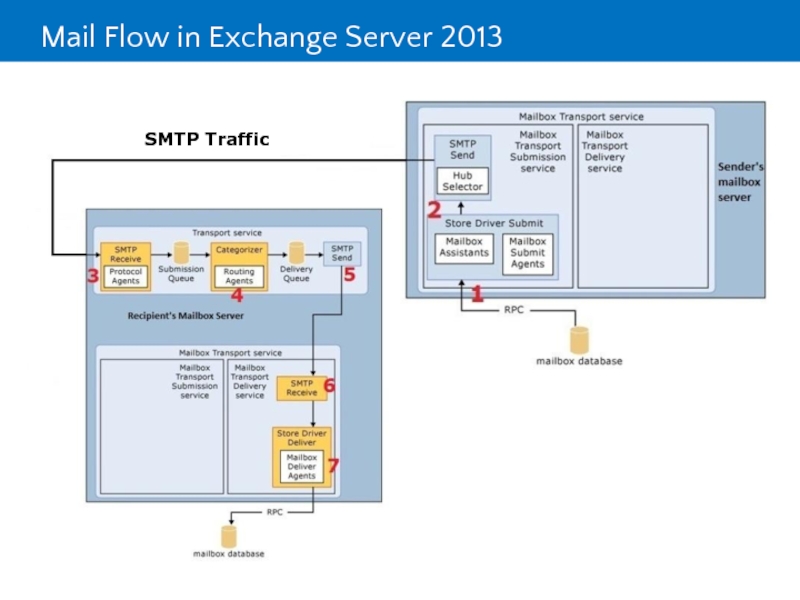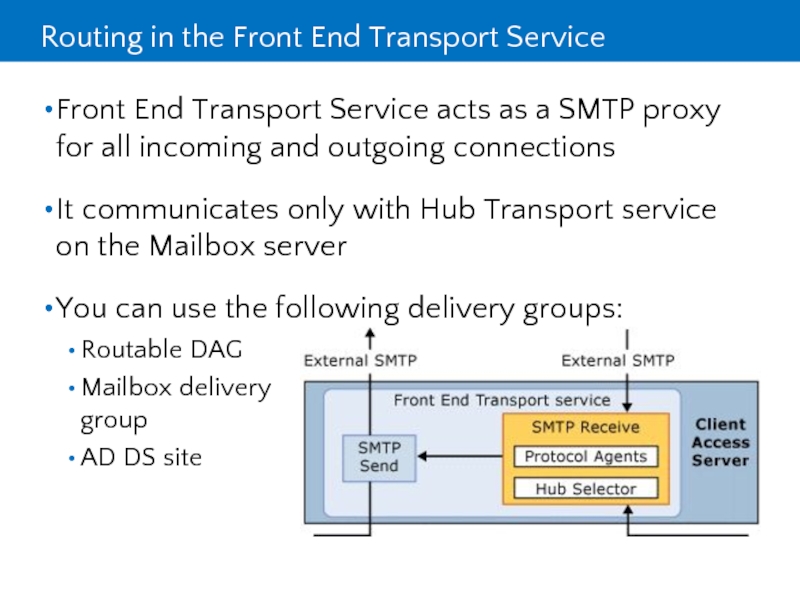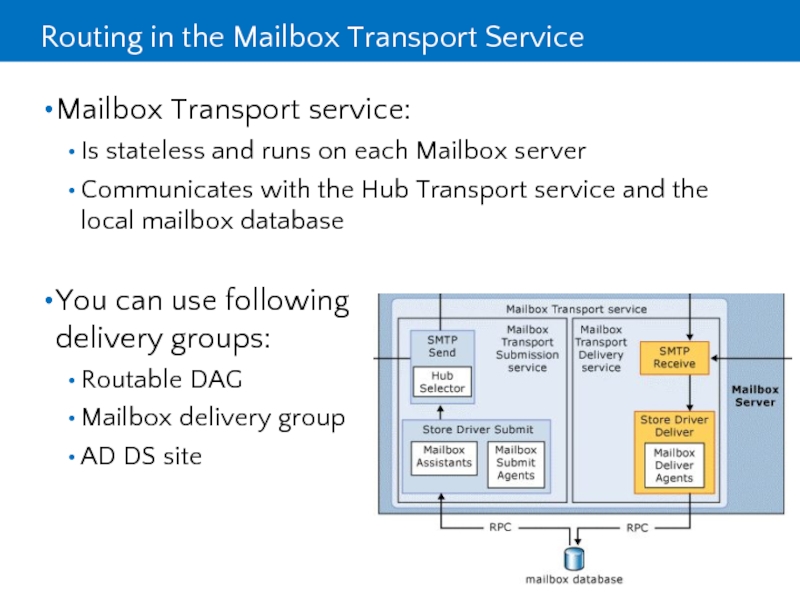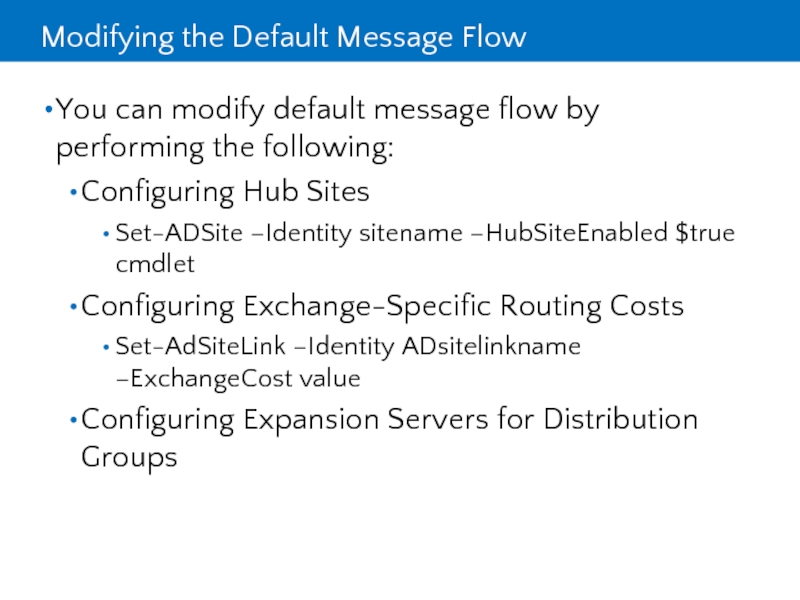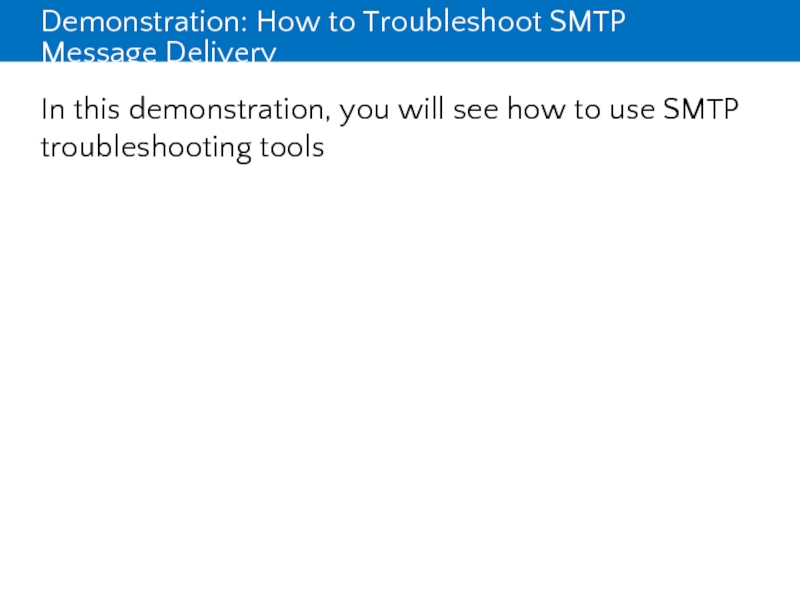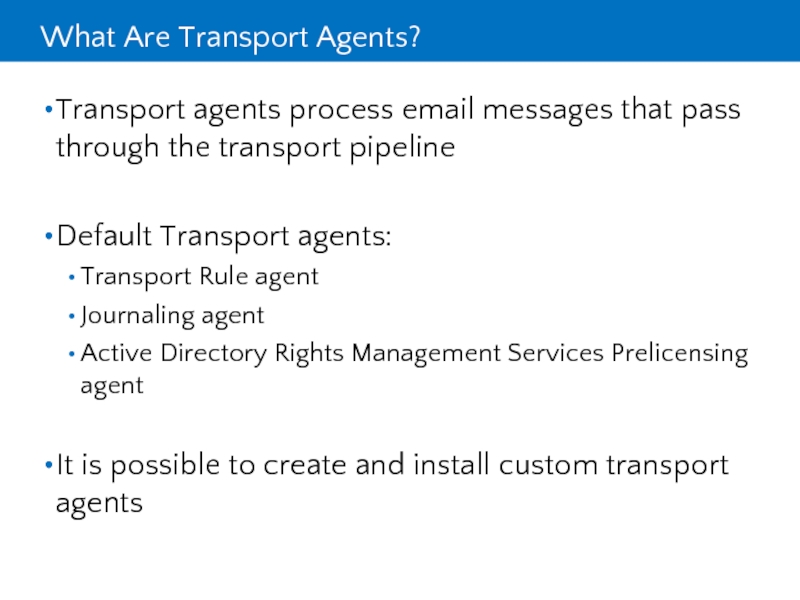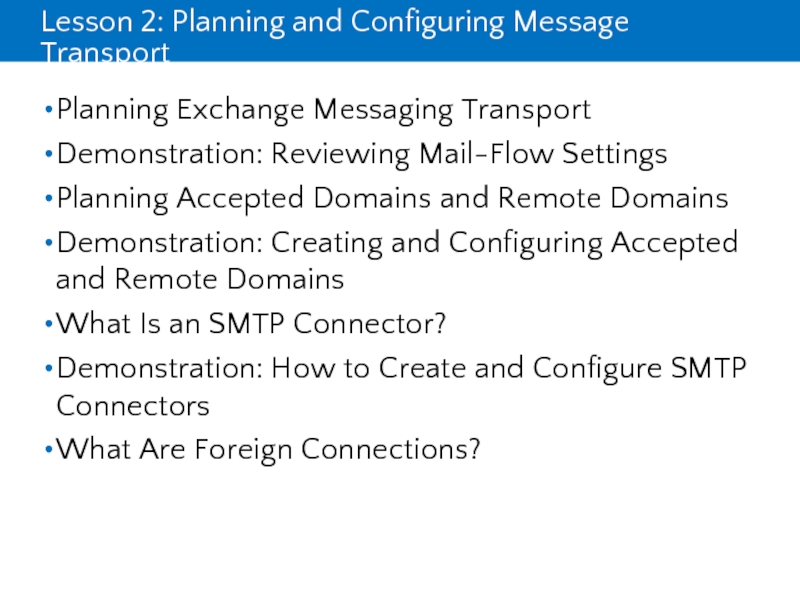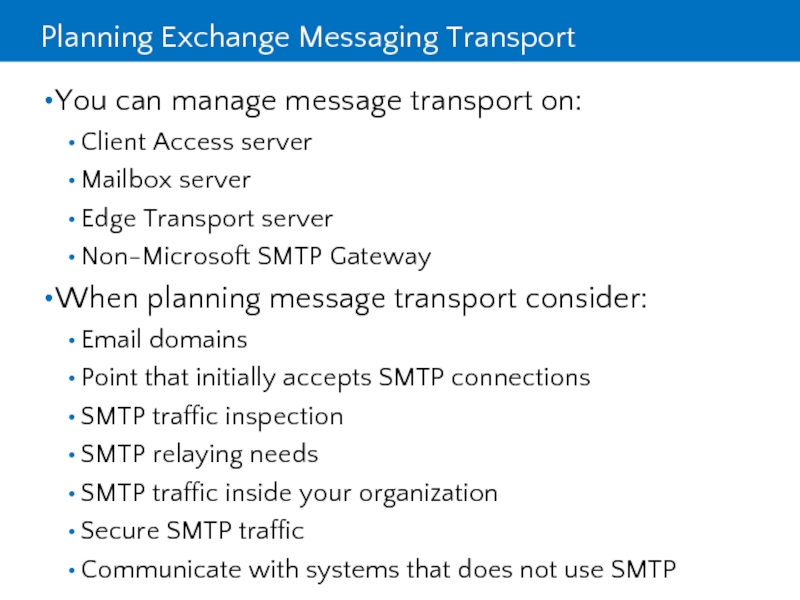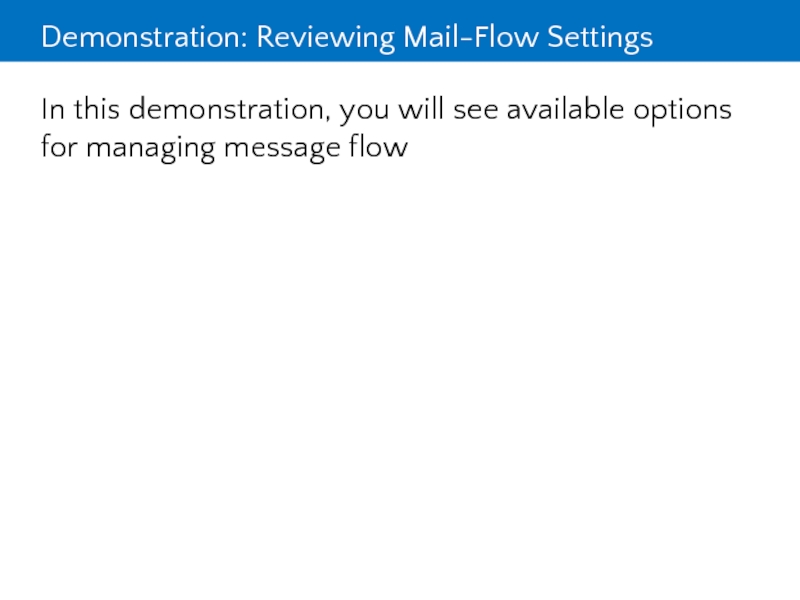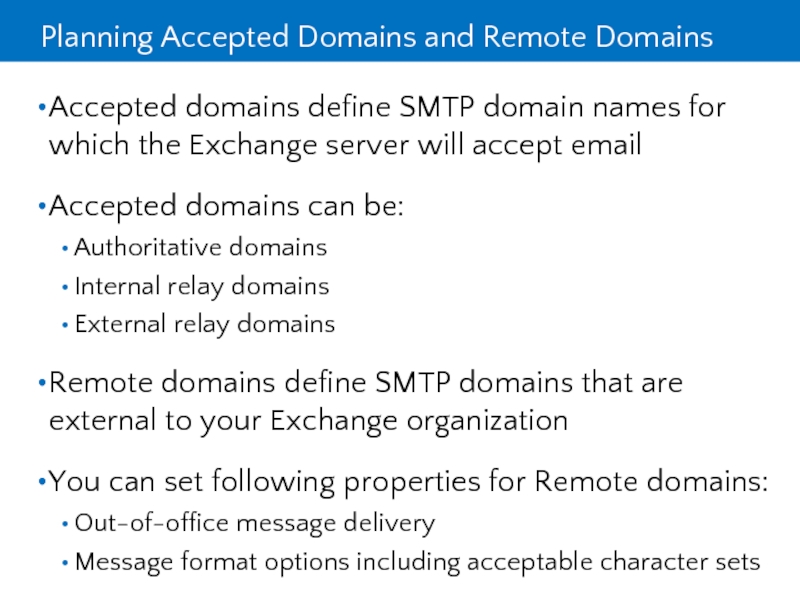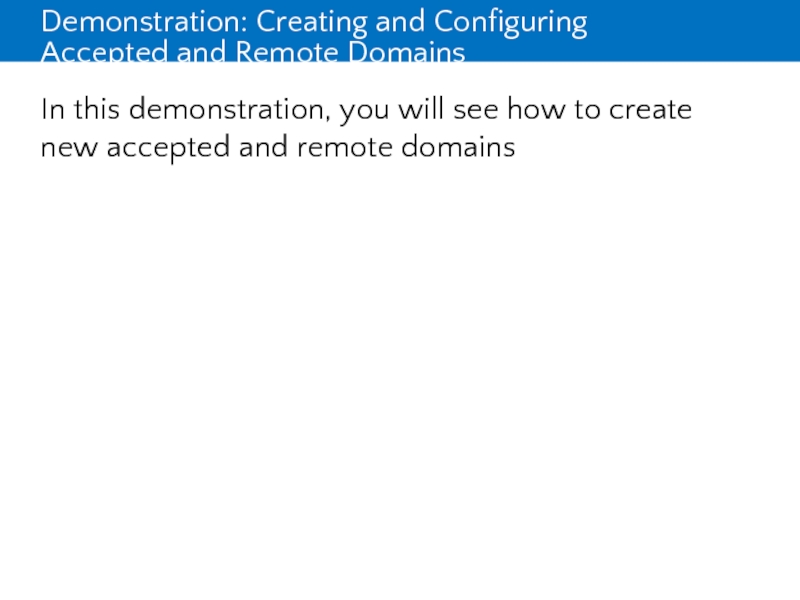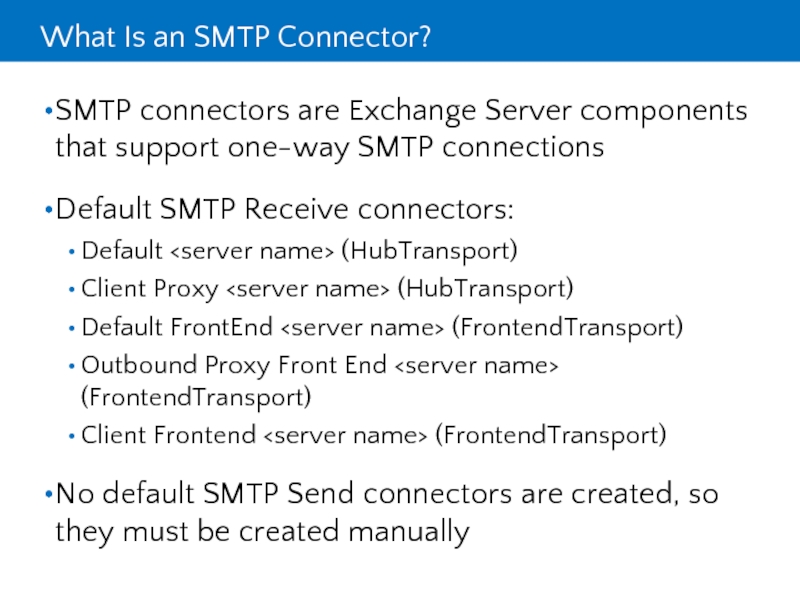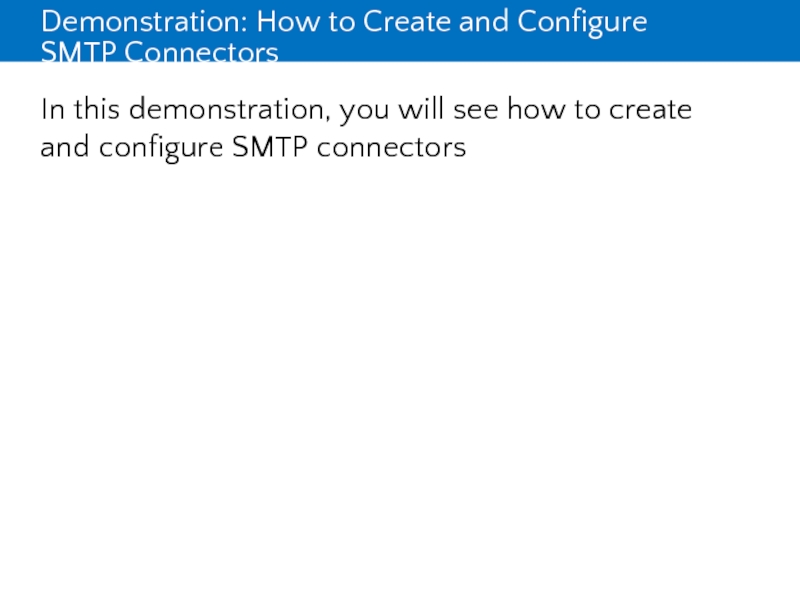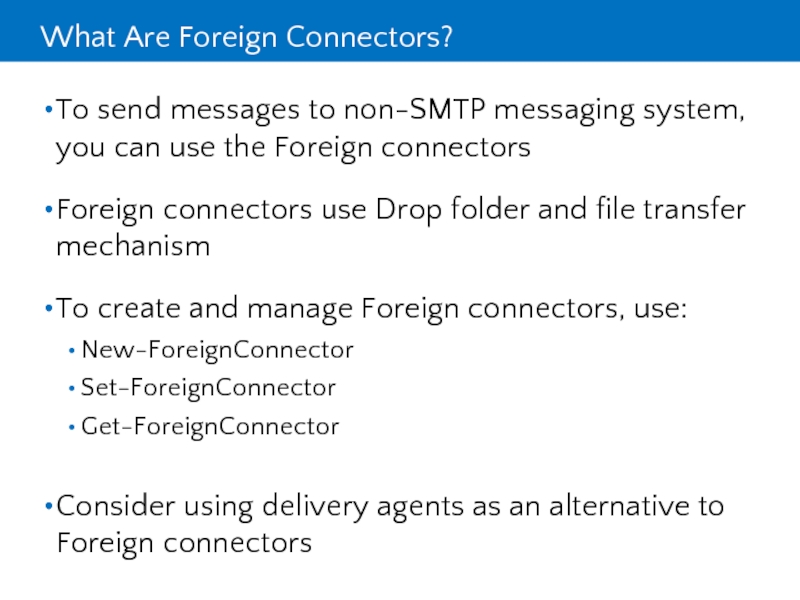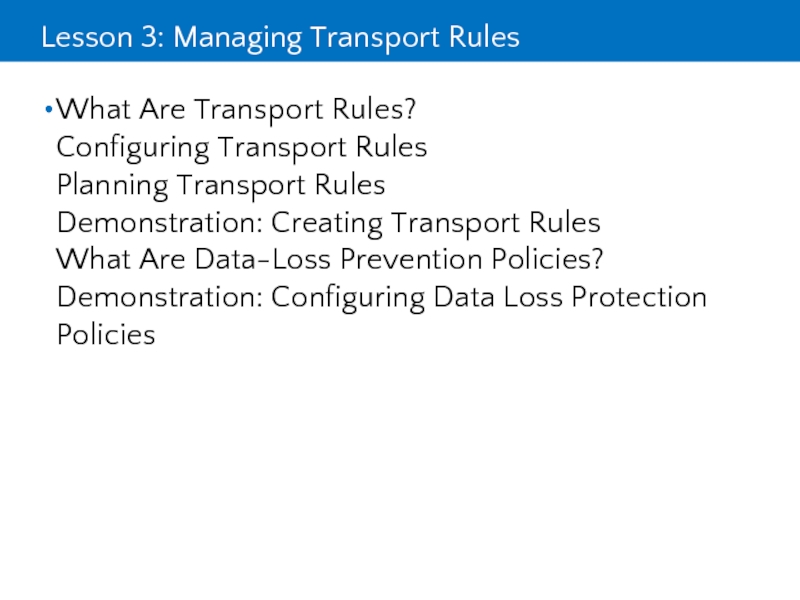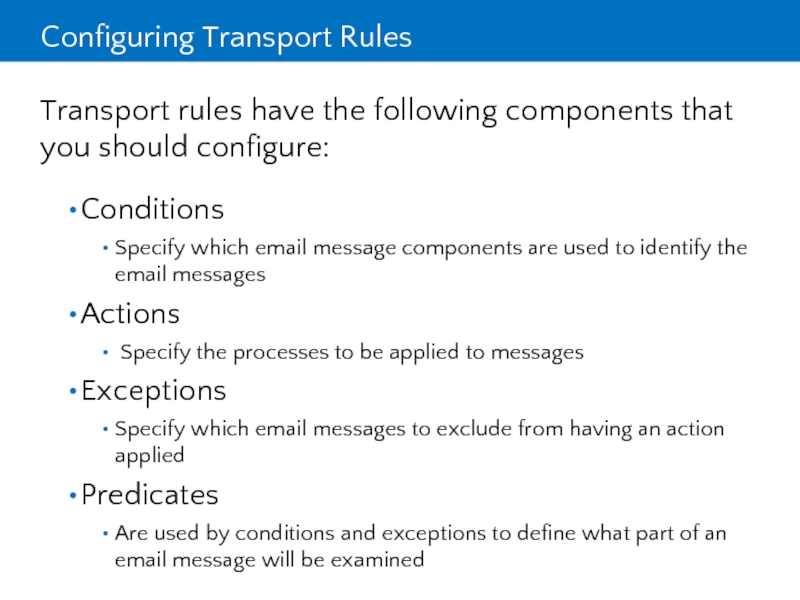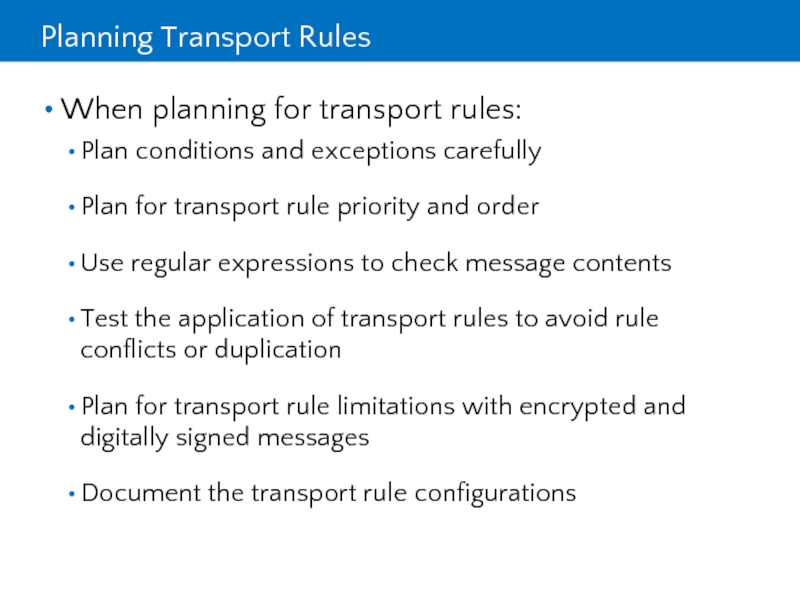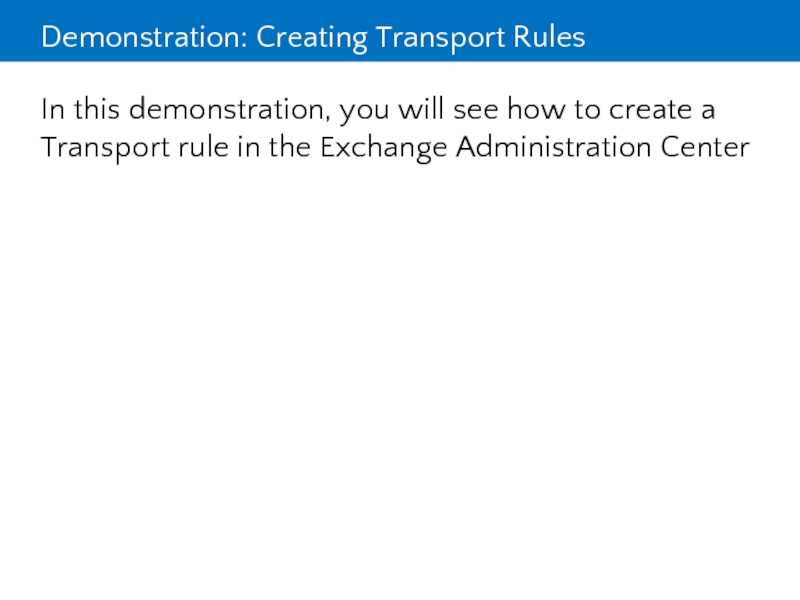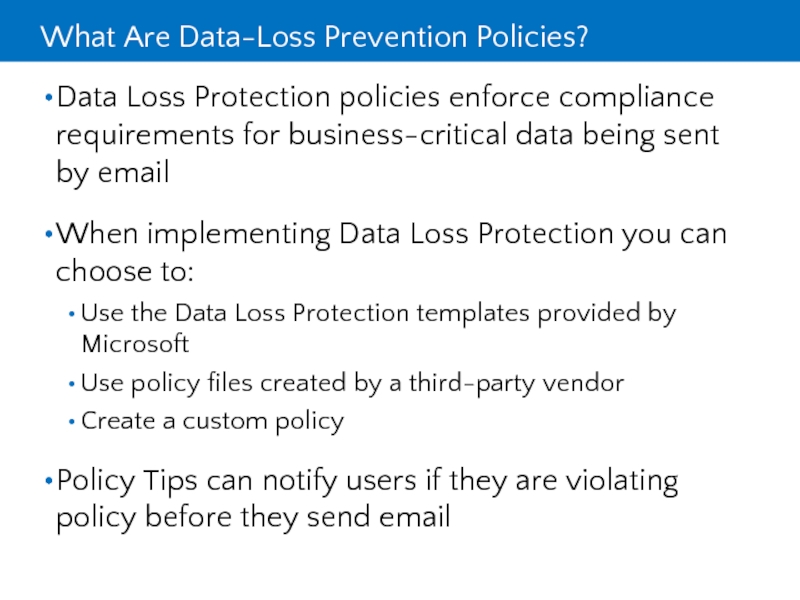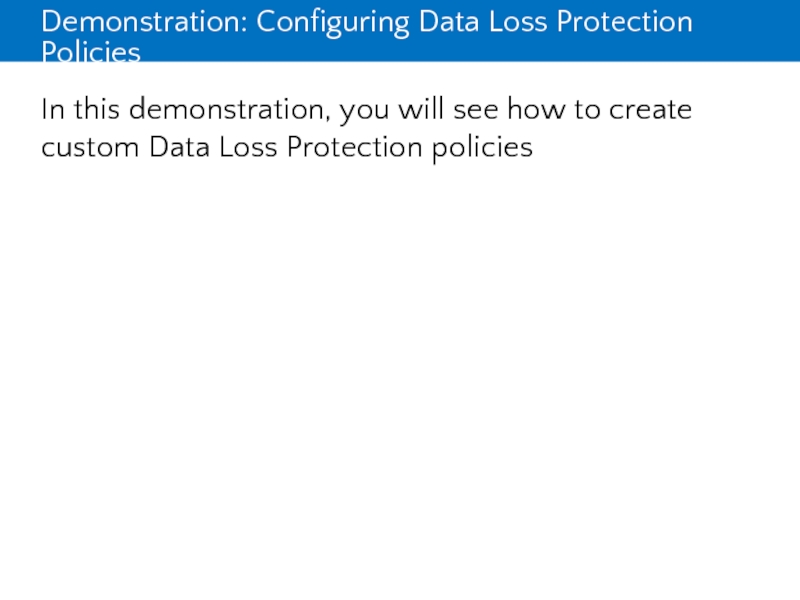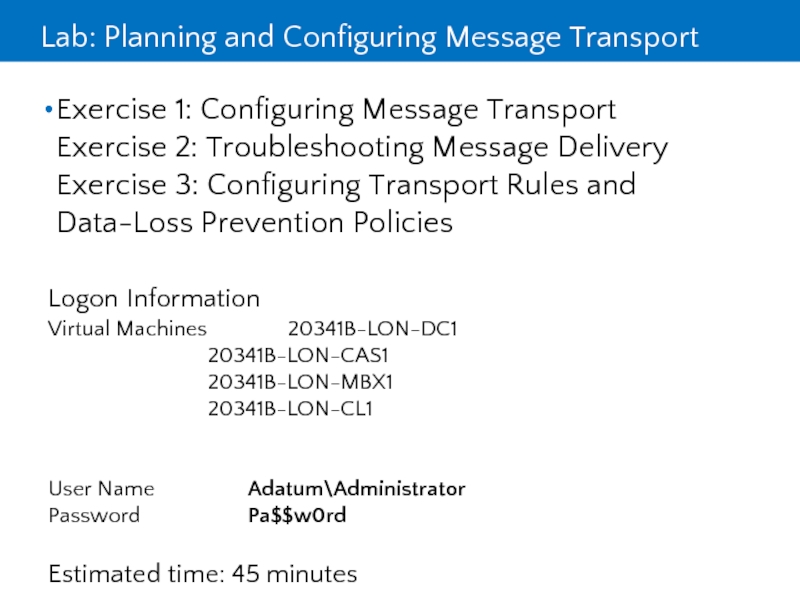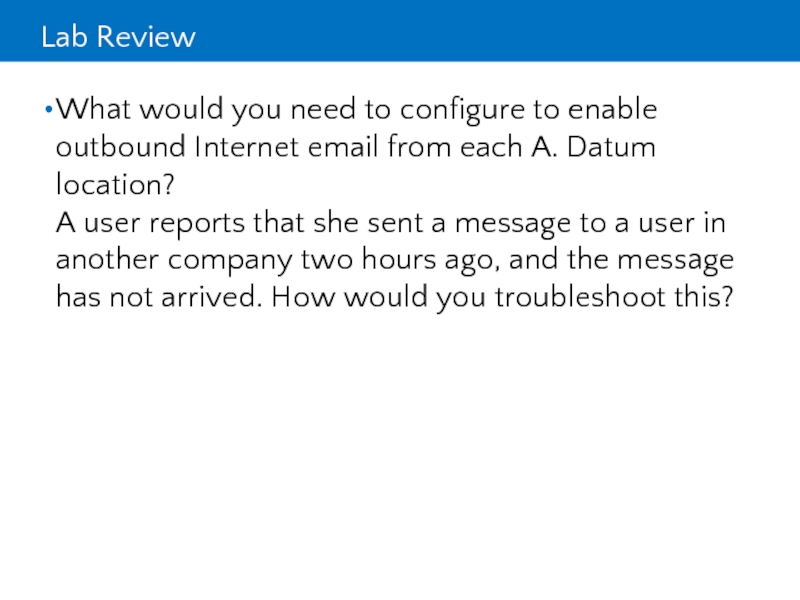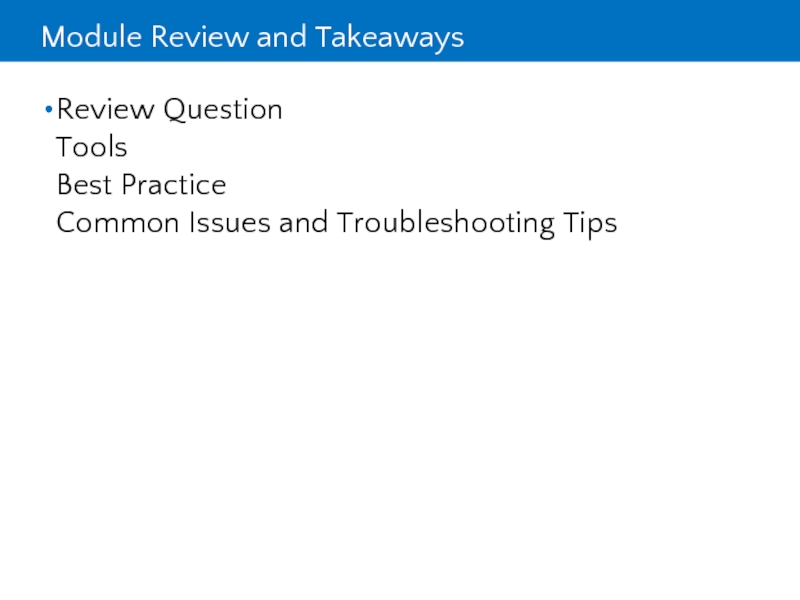- Главная
- Разное
- Дизайн
- Бизнес и предпринимательство
- Аналитика
- Образование
- Развлечения
- Красота и здоровье
- Финансы
- Государство
- Путешествия
- Спорт
- Недвижимость
- Армия
- Графика
- Культурология
- Еда и кулинария
- Лингвистика
- Английский язык
- Астрономия
- Алгебра
- Биология
- География
- Детские презентации
- Информатика
- История
- Литература
- Маркетинг
- Математика
- Медицина
- Менеджмент
- Музыка
- МХК
- Немецкий язык
- ОБЖ
- Обществознание
- Окружающий мир
- Педагогика
- Русский язык
- Технология
- Физика
- Философия
- Химия
- Шаблоны, картинки для презентаций
- Экология
- Экономика
- Юриспруденция
Microsoft official course. Planning and configuring message. Transport. (Module 8) презентация
Содержание
- 1. Microsoft official course. Planning and configuring message. Transport. (Module 8)
- 2. Module Overview Overview of Message Transport and
- 3. Lesson 1: Overview of Message Transport and
- 4. Message Transport Services Message Transport Services: Front
- 5. Message Transport Components
- 6. Message-Routing Changes in Exchange Server 2013 Changes
- 7. Routing Destinations and Delivery Groups Routing destinations:
- 8. Mail Flow in Exchange Server 2013 SMTP SMTP Traffic
- 9. Routing in the Front End Transport Service
- 10. Routing in the Mailbox Transport Service Mailbox
- 11. Modifying the Default Message Flow You can
- 12. Tools for Troubleshooting SMTP Message Delivery Queue
- 13. Demonstration: How to Troubleshoot SMTP Message Delivery
- 16. What Are Transport Agents? Transport agents process
- 17. Lesson 2: Planning and Configuring Message Transport
- 18. Planning Exchange Messaging Transport You can manage
- 19. Demonstration: Reviewing Mail-Flow Settings In this demonstration,
- 20. Planning Accepted Domains and Remote Domains Accepted
- 21. Demonstration: Creating and Configuring Accepted and Remote
- 22. What Is an SMTP Connector? SMTP connectors
- 23. Demonstration: How to Create and Configure SMTP
- 25. What Are Foreign Connectors? To send messages
- 26. Lesson 3: Managing Transport Rules What Are
- 27. What Are Transport Rules? Transport rules restrict
- 28. Configuring Transport Rules Transport rules have the
- 29. Planning Transport Rules When planning for transport
- 30. Demonstration: Creating Transport Rules In this demonstration,
- 32. What Are Data-Loss Prevention Policies? Data Loss
- 33. Demonstration: Configuring Data Loss Protection Policies In
- 35. Lab: Planning and Configuring Message Transport Exercise
- 36. Lab Scenario You are a messaging administrator
- 37. Lab Review What would you need to
- 38. Module Review and Takeaways Review Question Tools Best Practice Common Issues and Troubleshooting Tips
Слайд 2Module Overview
Overview of Message Transport and Routing
Planning and Configuring Message Transport
Managing
Transport Rules
Слайд 3Lesson 1: Overview of Message Transport and Routing
Message Transport Services
Message Transport
Components
Message-Routing Changes in Exchange Server 2013
Routing Destinations and Delivery Groups
Mail Flow in Exchange Server 2013
Routing in the Front End Transport Service
Routing in the Mailbox Transport Service
Modifying the Default Message Flow
Tools for Troubleshooting SMTP Message Delivery
Demonstration: How to Troubleshoot SMTP Message Delivery
What Are Transport Agents?
Слайд 4Message Transport Services
Message Transport Services:
Front End Transport service
Runs on the Client
Access server role
Performs SMTP proxying
Hub Transport service
Runs on the Mailbox Server role
Routes messages between the Front End Transport Service and the Mailbox Transport Service
Mailbox Transport service
Runs on the Mailbox Server role
Consists of two components: Mailbox Transport Submission and Mailbox Transport Delivery
Is the only service that handles RPC communication with the database
Performs SMTP proxying
Hub Transport service
Runs on the Mailbox Server role
Routes messages between the Front End Transport Service and the Mailbox Transport Service
Mailbox Transport service
Runs on the Mailbox Server role
Consists of two components: Mailbox Transport Submission and Mailbox Transport Delivery
Is the only service that handles RPC communication with the database
Слайд 6Message-Routing Changes in Exchange Server 2013
Changes in message routing in Exchange
2013 are:
Routing is aware of DAGs
Transport service runs on Mailbox Server
Queuing for remote destinations is more precise
Linked connectors have been deprecated
Routing is aware of DAGs
Transport service runs on Mailbox Server
Queuing for remote destinations is more precise
Linked connectors have been deprecated
Слайд 7Routing Destinations and Delivery Groups
Routing destinations:
Mailbox database
Connector
Distribution group expansion server
Delivery Groups:
Routable
DAG
Mailbox delivery group
Connector source servers
AD DS site
Server list
Mailbox delivery group
Connector source servers
AD DS site
Server list
Слайд 9Routing in the Front End Transport Service
Front End Transport Service acts
as a SMTP proxy for all incoming and outgoing connections
It communicates only with Hub Transport service on the Mailbox server
You can use the following delivery groups:
Routable DAG
Mailbox delivery group
AD DS site
It communicates only with Hub Transport service on the Mailbox server
You can use the following delivery groups:
Routable DAG
Mailbox delivery group
AD DS site
Слайд 10Routing in the Mailbox Transport Service
Mailbox Transport service:
Is stateless and runs
on each Mailbox server
Communicates with the Hub Transport service and the local mailbox database
You can use following delivery groups:
Routable DAG
Mailbox delivery group
AD DS site
Communicates with the Hub Transport service and the local mailbox database
You can use following delivery groups:
Routable DAG
Mailbox delivery group
AD DS site
Слайд 11Modifying the Default Message Flow
You can modify default message flow by
performing the following:
Configuring Hub Sites
Set-ADSite –Identity sitename –HubSiteEnabled $true cmdlet
Configuring Exchange-Specific Routing Costs
Set-AdSiteLink –Identity ADsitelinkname –ExchangeCost value
Configuring Expansion Servers for Distribution Groups
Configuring Hub Sites
Set-ADSite –Identity sitename –HubSiteEnabled $true cmdlet
Configuring Exchange-Specific Routing Costs
Set-AdSiteLink –Identity ADsitelinkname –ExchangeCost value
Configuring Expansion Servers for Distribution Groups
Слайд 12Tools for Troubleshooting SMTP Message Delivery
Queue Viewer
Use to view and
manage undelivered messages
Tracking logs and Delivery reports
Use to confirm message delivery
Protocol Logging
Use to provide detailed protocol-level information
Telnet
Use to check if the SMTP port responds, or to directly send a SMTP mail to a connector
Remote Connectivity Analyzer website
Use to test connectivity to Exchange services from the Internet
Tracking logs and Delivery reports
Use to confirm message delivery
Protocol Logging
Use to provide detailed protocol-level information
Telnet
Use to check if the SMTP port responds, or to directly send a SMTP mail to a connector
Remote Connectivity Analyzer website
Use to test connectivity to Exchange services from the Internet
Слайд 13Demonstration: How to Troubleshoot SMTP Message Delivery
In this demonstration, you will
see how to use SMTP troubleshooting tools
Слайд 16What Are Transport Agents?
Transport agents process email messages that pass through
the transport pipeline
Default Transport agents:
Transport Rule agent
Journaling agent
Active Directory Rights Management Services Prelicensing agent
It is possible to create and install custom transport agents
Default Transport agents:
Transport Rule agent
Journaling agent
Active Directory Rights Management Services Prelicensing agent
It is possible to create and install custom transport agents
Слайд 17Lesson 2: Planning and Configuring Message Transport
Planning Exchange Messaging Transport
Demonstration: Reviewing
Mail-Flow Settings
Planning Accepted Domains and Remote Domains
Demonstration: Creating and Configuring Accepted and Remote Domains
What Is an SMTP Connector?
Demonstration: How to Create and Configure SMTP Connectors
What Are Foreign Connections?
Planning Accepted Domains and Remote Domains
Demonstration: Creating and Configuring Accepted and Remote Domains
What Is an SMTP Connector?
Demonstration: How to Create and Configure SMTP Connectors
What Are Foreign Connections?
Слайд 18Planning Exchange Messaging Transport
You can manage message transport on:
Client Access server
Mailbox server
Edge Transport server
Non-Microsoft SMTP Gateway
When planning message transport consider:
Email domains
Point that initially accepts SMTP connections
SMTP traffic inspection
SMTP relaying needs
SMTP traffic inside your organization
Secure SMTP traffic
Communicate with systems that does not use SMTP
Слайд 19Demonstration: Reviewing Mail-Flow Settings
In this demonstration, you will see available options
for managing message flow
Слайд 20Planning Accepted Domains and Remote Domains
Accepted domains define SMTP domain names
for which the Exchange server will accept email
Accepted domains can be:
Authoritative domains
Internal relay domains
External relay domains
Remote domains define SMTP domains that are external to your Exchange organization
You can set following properties for Remote domains:
Out-of-office message delivery
Message format options including acceptable character sets
Accepted domains can be:
Authoritative domains
Internal relay domains
External relay domains
Remote domains define SMTP domains that are external to your Exchange organization
You can set following properties for Remote domains:
Out-of-office message delivery
Message format options including acceptable character sets
Слайд 21Demonstration: Creating and Configuring Accepted and Remote Domains
In this demonstration, you
will see how to create new accepted and remote domains
Слайд 22What Is an SMTP Connector?
SMTP connectors are Exchange Server components that
support one-way SMTP connections
Default SMTP Receive connectors:
Default (HubTransport)
Client Proxy (HubTransport)
Default FrontEnd (FrontendTransport)
Outbound Proxy Front End (FrontendTransport)
Client Frontend (FrontendTransport)
No default SMTP Send connectors are created, so they must be created manually
Default SMTP Receive connectors:
Default
Client Proxy
Default FrontEnd
Outbound Proxy Front End
Client Frontend
No default SMTP Send connectors are created, so they must be created manually
Слайд 23Demonstration: How to Create and Configure SMTP Connectors
In this demonstration, you
will see how to create and configure SMTP connectors
Слайд 25What Are Foreign Connectors?
To send messages to non-SMTP messaging system, you
can use the Foreign connectors
Foreign connectors use Drop folder and file transfer mechanism
To create and manage Foreign connectors, use:
New-ForeignConnector
Set-ForeignConnector
Get-ForeignConnector
Consider using delivery agents as an alternative to Foreign connectors
Foreign connectors use Drop folder and file transfer mechanism
To create and manage Foreign connectors, use:
New-ForeignConnector
Set-ForeignConnector
Get-ForeignConnector
Consider using delivery agents as an alternative to Foreign connectors
Слайд 26Lesson 3: Managing Transport Rules
What Are Transport Rules?
Configuring Transport Rules
Planning Transport
Rules
Demonstration: Creating Transport Rules
What Are Data-Loss Prevention Policies?
Demonstration: Configuring Data Loss Protection Policies
Слайд 27What Are Transport Rules?
Transport rules restrict message flow or modify message
contents for messages in transit
Transport rules have the following chracteristics:
They are stored in the AD DS Configuration partition
They are applied by all Mailbox servers
They are used to apply compliance requirements
Transport rules have the following chracteristics:
They are stored in the AD DS Configuration partition
They are applied by all Mailbox servers
They are used to apply compliance requirements
Слайд 28Configuring Transport Rules
Transport rules have the following components that you should
configure:
Conditions
Specify which email message components are used to identify the email messages
Actions
Specify the processes to be applied to messages
Exceptions
Specify which email messages to exclude from having an action applied
Predicates
Are used by conditions and exceptions to define what part of an email message will be examined
Conditions
Specify which email message components are used to identify the email messages
Actions
Specify the processes to be applied to messages
Exceptions
Specify which email messages to exclude from having an action applied
Predicates
Are used by conditions and exceptions to define what part of an email message will be examined
Слайд 29Planning Transport Rules
When planning for transport rules:
Plan conditions and exceptions carefully
Plan
for transport rule priority and order
Use regular expressions to check message contents
Test the application of transport rules to avoid rule conflicts or duplication
Plan for transport rule limitations with encrypted and digitally signed messages
Document the transport rule configurations
Use regular expressions to check message contents
Test the application of transport rules to avoid rule conflicts or duplication
Plan for transport rule limitations with encrypted and digitally signed messages
Document the transport rule configurations
Слайд 30Demonstration: Creating Transport Rules
In this demonstration, you will see how to
create a Transport rule in the Exchange Administration Center
Слайд 32What Are Data-Loss Prevention Policies?
Data Loss Protection policies enforce compliance requirements
for business-critical data being sent by email
When implementing Data Loss Protection you can choose to:
Use the Data Loss Protection templates provided by Microsoft
Use policy files created by a third-party vendor
Create a custom policy
Policy Tips can notify users if they are violating policy before they send email
When implementing Data Loss Protection you can choose to:
Use the Data Loss Protection templates provided by Microsoft
Use policy files created by a third-party vendor
Create a custom policy
Policy Tips can notify users if they are violating policy before they send email
Слайд 33Demonstration: Configuring Data Loss Protection Policies
In this demonstration, you will see
how to create custom Data Loss Protection policies
Слайд 35Lab: Planning and Configuring Message Transport
Exercise 1: Configuring Message Transport
Exercise 2:
Troubleshooting Message Delivery
Exercise 3: Configuring Transport Rules and
Data-Loss Prevention Policies
Logon Information
Estimated time: 45 minutes
Virtual Machines 20341B-LON-DC1
20341B-LON-CAS1
20341B-LON-MBX1
20341B-LON-CL1
User Name Adatum\Administrator
Password Pa$$w0rd
Слайд 36Lab Scenario
You are a messaging administrator in A. Datum Corporation, which
is a large multinational organization that has offices in several cities. Your organization has deployed Exchange Server 2013. You need to configure Exchange Server to send messages to the Internet and receive messages from the Internet. You also need to ensure that you can troubleshoot message transport, if necessary. At the end, you need to implement some configure message transport rules, according to the corporate security policy.
Слайд 37Lab Review
What would you need to configure to enable outbound Internet
email from each A. Datum location?
A user reports that she sent a message to a user in another company two hours ago, and the message has not arrived. How would you troubleshoot this?
